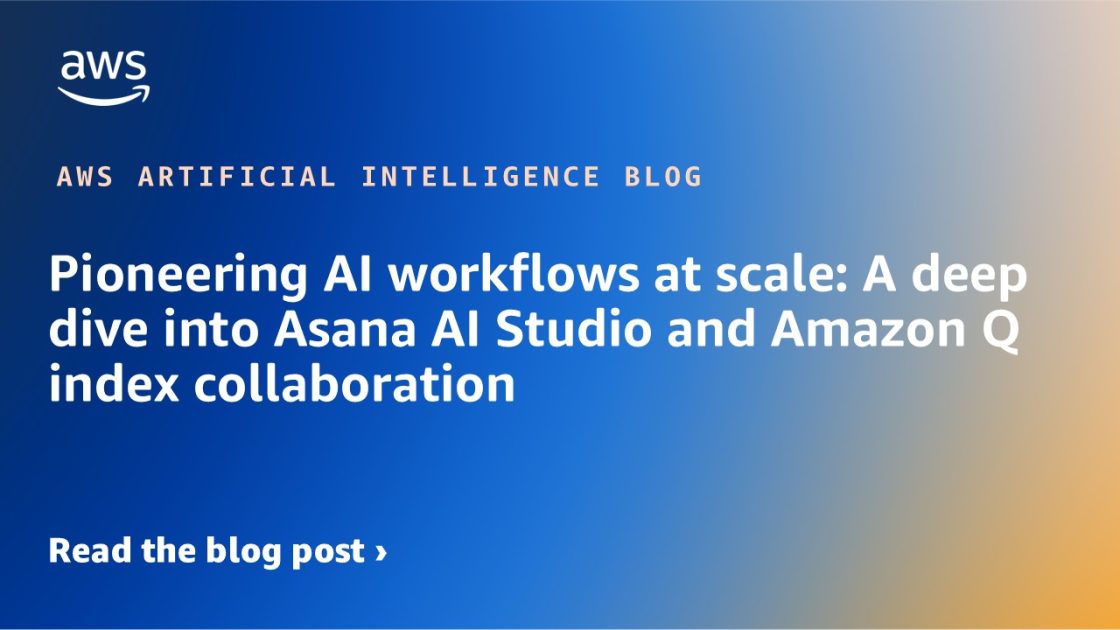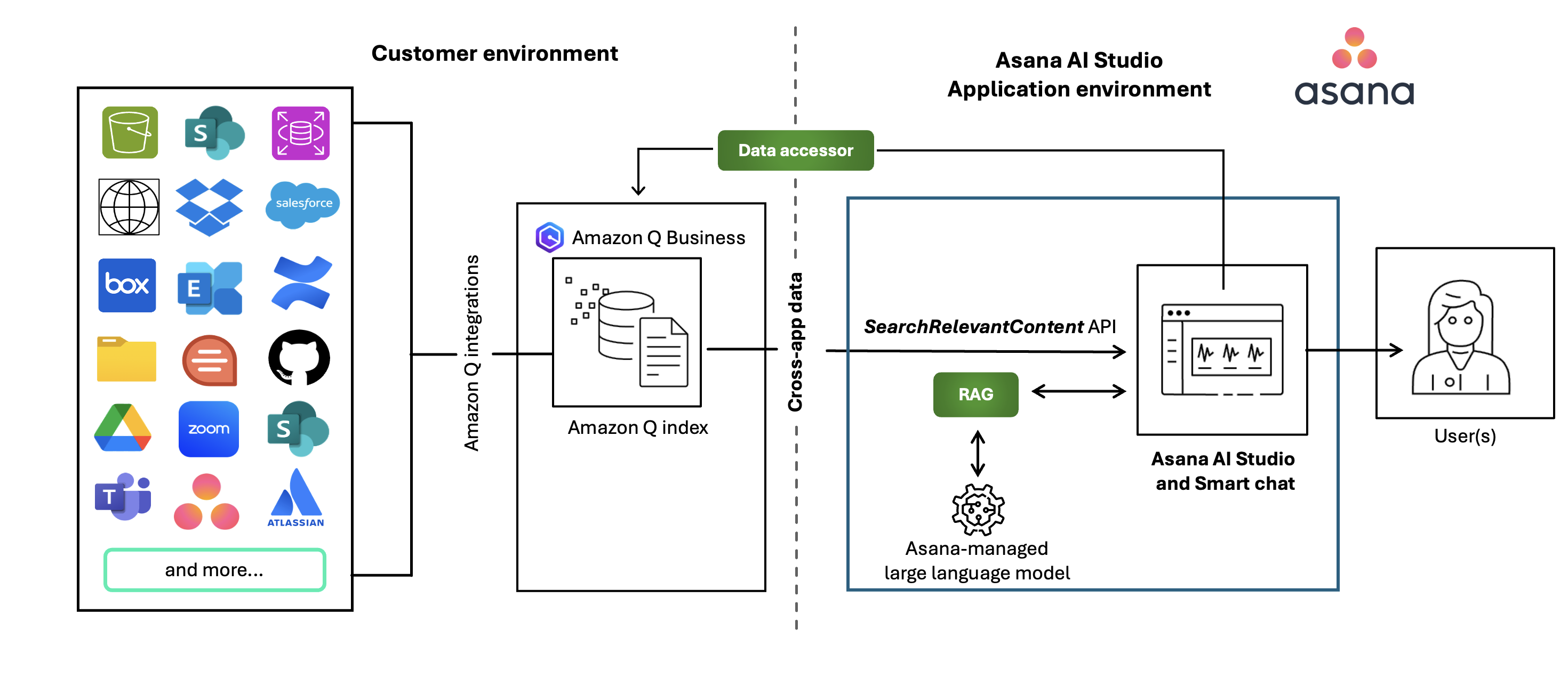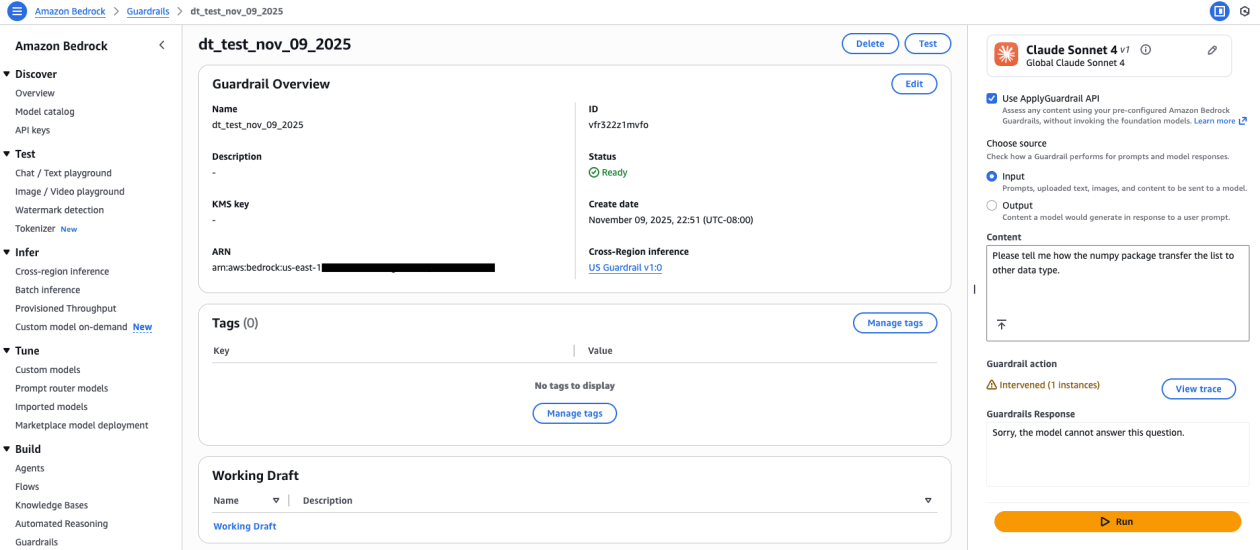Organizations today face a critical challenge: managing an ever-increasing volume of tasks and information across multiple systems. Although traditional task management tools help organize work, they often fall short in delivering the intelligence needed for truly efficient operations.
Today, we’re excited to announce the integration of Asana AI Studio with Amazon Q index, bringing generative AI directly into your daily workflows. This dynamic combination helps teams work smarter by powering AI workflows at scale with data from everyday applications. The result is seamless automation for key use cases like project intake, campaign management, and product launches, transforming how teams work and deliver results.
In this post, we explore how Asana AI Studio and Amazon Q index transform enterprise efficiency through intelligent workflow automation and enhanced data accessibility. We start by examining the core capabilities of this powerful integration. Then we dive deep into the technical implementation and a step-by-step process of how to set up the Amazon Q Business data accessor and configure the Asana admin console. Throughout the post, we cover essential topics including security considerations, access controls, and best practices for maximizing the value of this integration.
Whether you’re looking to streamline operations, improve decision-making, or break down data silos, this comprehensive guide will show you how to harness the full potential of Asana AI Studio and Amazon Q index in your enterprise environment.
The power of integrating Asana AI Studio with Amazon Q index
Asana AI Studio represents a breakthrough in no-code automation, helping teams create and deploy AI-powered workflows that streamline operations and minimize routine busywork. As the leading work management service for human and AI coordination, Asana offers enterprise-grade solutions that break down traditional data silos and enhance collaboration through AI-driven automation and insights.
Amazon Q index for independent software vendors (ISVs) provides seamless integration of generative AI applications with enterprise data and metadata through an Amazon Q index, so you can search across your application data alongside other enterprise content. This integration capability makes sure ISVs can provide their customers with a unified search experience while maintaining strict security, access controls, and ownership over their data.
With the refined indexing of Amazon Q combined with Asana’s comprehensive work management data, organizations can transform how they harness the power of their data.
Through the Amazon Q Business data accessor capability, Asana can securely tap into and analyze information from diverse business applications, converting previously isolated data into meaningful business intelligence. This unlocks key use cases like project intake, campaign management, and product launches, all while maintaining data security.
The following video demonstrates this solution in action, as a team member uses Asana to quickly access project information, create automated workflows, and receive AI-powered recommendations for task optimization across connected services.
How the integration benefits enterprises
Organizations can transform scattered information into real business outcomes with the combined power of Asana AI Studio and Amazon Q index:
- Connect applications in minutes – Use cross-application data quickly and confidently with one-time setup and secure permissions
- Build integrated workflows – Design AI-powered workflows that unify teams and applications, with no code required
- Scale AI company-wide safely and securely – Access real-time data and insights where your teams already work while the system intelligently maintains strict security protocols and existing access control list (ACL) permissions to help keep sensitive information protected
Spencer Herrick, Principal AI Product Manager at Asana, shares:
“At Asana, we’re committed to helping teams move faster with clarity and confidence. Integrating Amazon Q index into our AI infrastructure is a powerful step forward—it allows us to unify knowledge scattered across enterprise systems and surface highly relevant insights directly in workflows. This not only accelerates decision-making but also improves the quality of execution across teams. AWS has been an exceptional partner throughout this process, and we’re thrilled by the early results and the opportunity to continue innovating on top of this foundation.”
Solution overview
The Amazon Q Business data accessor functions as a secure gateway, linking enterprise tools to the Amazon Q index. This component offers organizations a protected channel through which Asana AI Studio can retrieve information from their Amazon Q index. This enables Asana’s AI features to provide relevant answers to user queries by incorporating data from various connected systems.
The result is an AI-powered experience that combines Asana’s work management capabilities with your organization’s broader information landscape that uses enterprise data across multiple systems. When a user asks a question through smart chat or triggers an AI Studio workflow, Asana’s AI orchestrator processes the query, checking both Asana’s native data for relevant information as well as the Amazon Q Business data accessor to search the Amazon Q index, hosted across the customer’s AWS environment. The index can aggregate data from various enterprise systems such as Google Workspace, Microsoft 365, and Salesforce using built-in Amazon Q Business connectors. The orchestrator then uses generative AI to provide users with contextual, actionable insights directly within the Asana system. With this integration, teams can quickly access project documentation, communication history, and other critical information, enhancing productivity and decision-making efficiency across the aspects of work management.
The following diagram illustrates the overall solution integrating Asana AI Studio and Amazon Q index in the customer’s environment.
Prerequisites
To use the Amazon Q index integration with Asana’s AI features, you must have the following in place:
- An AWS account with the necessary permissions and service access
- An active Amazon Q Business setup, configured with AWS IAM Identity Center for user authentication
- Asana’s AI features enabled
- Super admin rights within your Asana workspace
The Amazon Q Business data accessor facilitates a smooth connection between Asana’s AI tools and your Amazon Q index. To implement this integration, you must perform some initial setup in both the Amazon Q Business environment and your Asana admin console. This typically involves configuring authentication methods, specifying which data sources to include, and setting appropriate access controls.
For a comprehensive guide on setting up Amazon Q Business, refer to Innovate on enterprise data with generative AI & Amazon Q Business application. For Asana-specific steps, you can find detailed instructions in the Asana Help Center for Amazon Q index, but we also cover key steps in this post.
Add Asana as a data accessor in Amazon Q Business
Complete the following steps to add Asana as an Amazon Q Business data accessor:
- On the Amazon Q Business console, choose Applications in the navigation pane.
- Open the application you want to add a data accessor to.
- Choose Data accessors in the navigation pane.
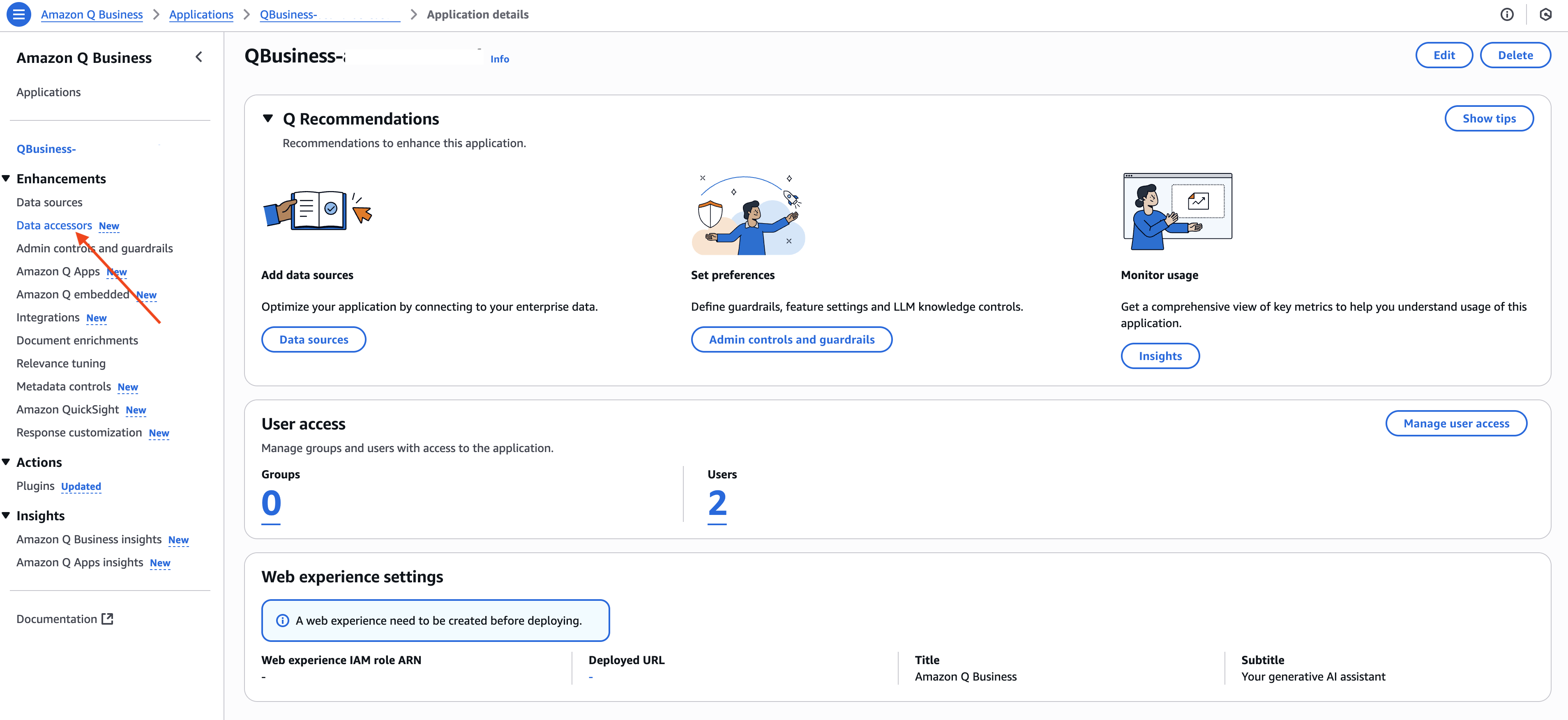
- Choose Add data accessor.
- For Data accessors, choose Asana.

- For External ID, enter the external ID provided to you by Asana.
In Asana, the tenant ID (or external ID) in the Amazon Q Business data accessor is called the domain ID. To retrieve the Asana domain ID, choose your account profile in Asana and choose Admin Console. Choose Settings, and scroll to Domain settings to retrieve the ID.
- Choose Create trusted token issuer.

- For Trusted token issuer name, enter the name of the trusted token issuer, then choose Create trusted token issuer.
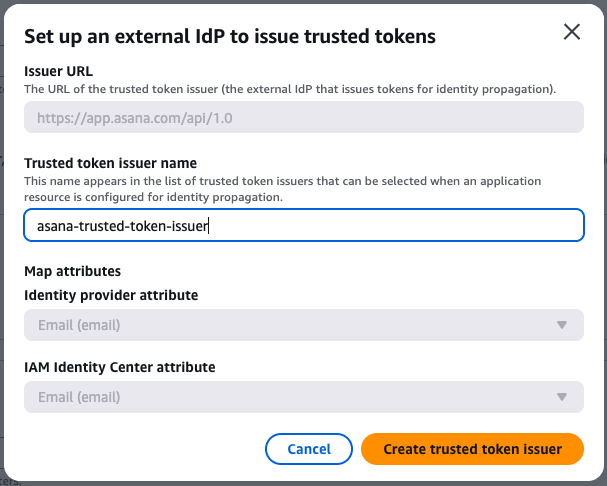
- For Data source access, select Allow access to all data sources.
- For User access, select All users with application access, or select Define access based on user and groups for more granular access control.
- Choose Add data accessor.

After you add Asana as a data accessor successfully, a pop-up window will appear with data accessor configuration details. Share the data accessor configuration details with Asana, because it uses them to make a secure connection from the Asana AI Studio system through the Amazon Q index SearchRelevantContent API to retrieve content from your Amazon Q index.

Connect an Amazon Q index to the Asana admin console
Connecting an Amazon Q index to Asana requires super admin permission. Complete the following steps to connect:
- Log in to the Asana admin console
- Choose Settings, Asana AI, and Data connectors.
- Choose Link account.
- Fill in the required fields with information gathered from the Amazon Q Business console.
- Choose Verify connection.
After an Amazon Q index is connected to Asana, the option Data to use from connected apps will appear in the rule builder settings within AI Studio. You can now start running workflow rules with enriched context from third-party data sources like Google Drive, Microsoft Outlook, and Salesforce, as shown in the following screenshot.
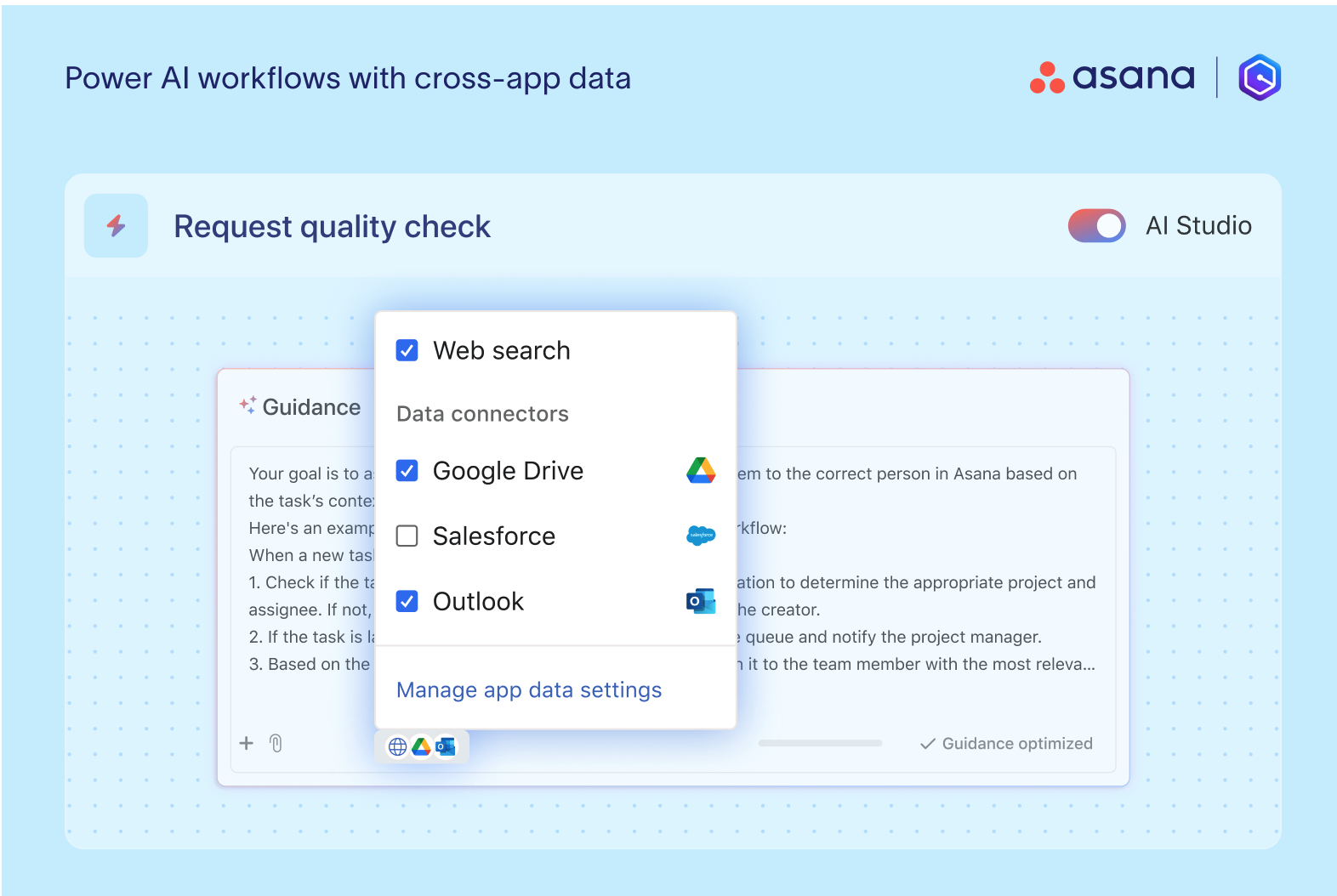
You can also use Asana smart chat in your Asana workspace and start asking questions. While interacting, smart chat will automatically search for relevant information across Asana and the connected third-party data sources like Google Drive using Amazon Q index to provide you with instant answers, as shown in the following screenshot.
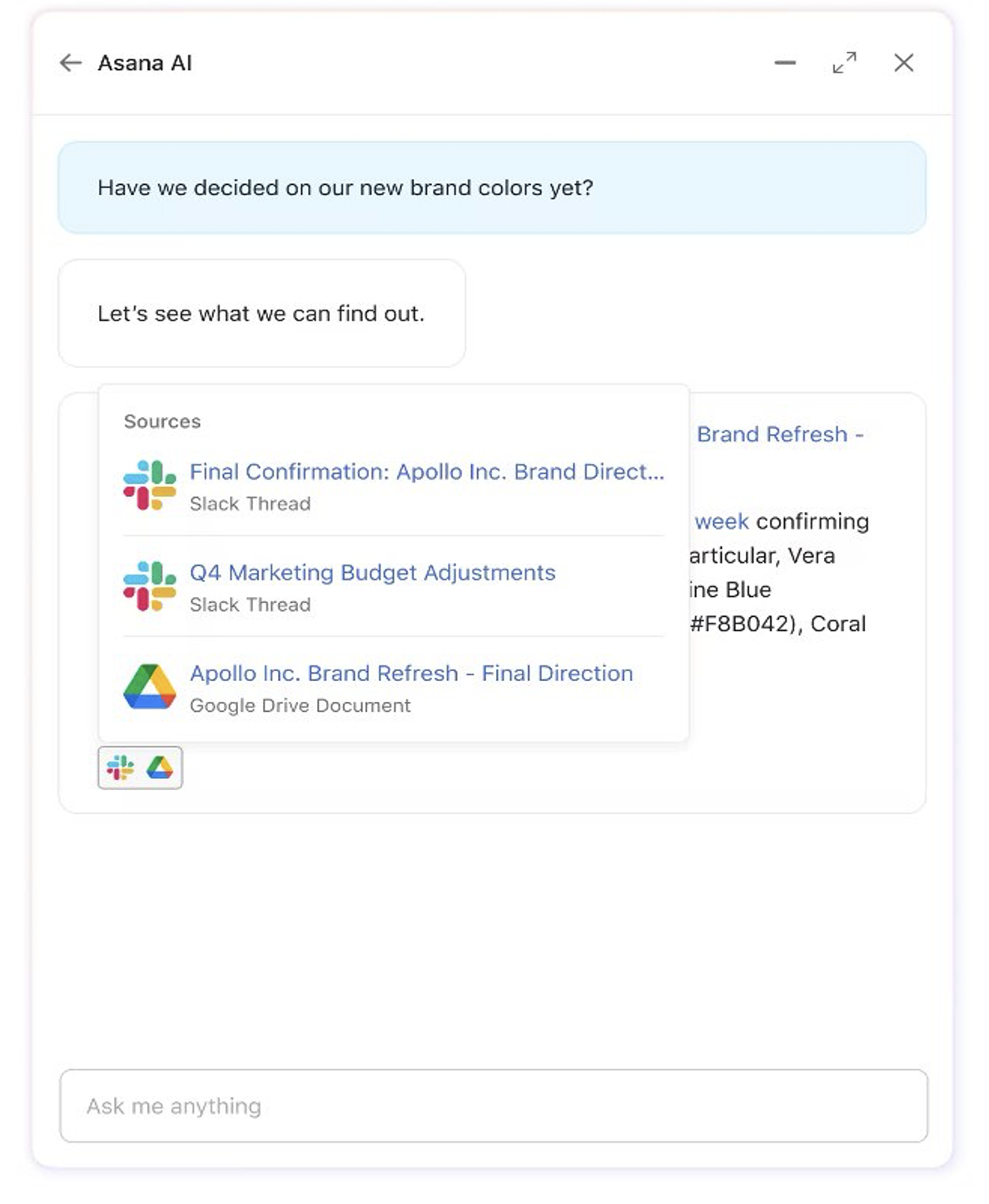
Clean up
When you’re done using this solution, clean up the resources you created:
- On your Asana admin page, navigate to Settings, Asana AI, Data connectors, and disconnect Amazon Q.

- On Amazon Q Business console, delete the Asana data accessor from the Data accessors page. Deleting this data accessor will delete permissions and access to the data accessor for users.
- Delete the Amazon Q Business application that you created as a prerequisite on the Applications page. Deleting the Amazon Q Business application will remove the associated index and data source connectors and avoid incurring additional costs.
Conclusion
This new Asana and Amazon Q index integration marks a significant advancement in intelligent work management. By merging Asana’s robust work management system with Amazon Q index’s comprehensive search capabilities, organizations can now effortlessly access and use information previously scattered across multiple systems. AI Studio users can craft more intelligent workflows by using external data through the new Data to use from connected apps option in the rule builder, and smart chat users can benefit from automatically cited responses that draw from both Asana and connected third-party sources. All of this is achieved while maintaining security and data ownership, effectively breaking down information silos that often hinder collaboration and efficiency.
Whether you’re aiming to increase efficiency, optimize workflows, or make more informed decisions, the Asana and Amazon Q index integration provides the necessary tools to transform how your organization works. We encourage you to explore the Amazon Q Business console and Asana’s AI features documentation to unlock the full potential of your connected workplace. By embracing this powerful integration, you’re not just improving your work management, you’re setting the stage for a more intelligent and efficient future for your team.
About the Authors
 Spencer Herrick is Principal AI Product Manager at Asana. He leads the development of AI-first products that help organizations seamlessly integrate new AI capabilities into collaborative work management. His journey into AI began not in Silicon Valley, but at the Large Hadron Collider in Switzerland, where he worked as an experimental physicist. Since then, Spencer has built and led innovative product teams at Grammarly, Uber, and Postmates, consistently pushing the boundaries of what’s possible at the intersection of AI, personalization, and user experience.
Spencer Herrick is Principal AI Product Manager at Asana. He leads the development of AI-first products that help organizations seamlessly integrate new AI capabilities into collaborative work management. His journey into AI began not in Silicon Valley, but at the Large Hadron Collider in Switzerland, where he worked as an experimental physicist. Since then, Spencer has built and led innovative product teams at Grammarly, Uber, and Postmates, consistently pushing the boundaries of what’s possible at the intersection of AI, personalization, and user experience.
 Sourabh Banerjee is a Senior WW GenAI specialist at AWS with over 10 years of experience in leading product and GTM strategy. Sourabh leads global strategy and execution for helping customers and partners unlock business productivity through Amazon Q Business across industries.
Sourabh Banerjee is a Senior WW GenAI specialist at AWS with over 10 years of experience in leading product and GTM strategy. Sourabh leads global strategy and execution for helping customers and partners unlock business productivity through Amazon Q Business across industries.
 Chinmayee Rane is a Generative AI Specialist Solutions Architect at AWS, with a core focus on generative AI. She helps ISVs accelerate the adoption of generative AI by designing scalable and impactful solutions. With a strong background in applied mathematics and machine learning, she specializes in intelligent document processing and AI-driven innovation. Outside of work, she enjoys salsa and bachata dancing.
Chinmayee Rane is a Generative AI Specialist Solutions Architect at AWS, with a core focus on generative AI. She helps ISVs accelerate the adoption of generative AI by designing scalable and impactful solutions. With a strong background in applied mathematics and machine learning, she specializes in intelligent document processing and AI-driven innovation. Outside of work, she enjoys salsa and bachata dancing.
 Bobby Williams is a Senior Solutions Architect at AWS. He has decades of experience designing, building, and supporting enterprise software solutions that scale globally. He works on solutions across industry verticals and horizontals and is driven to create a delightful experience for every customer.
Bobby Williams is a Senior Solutions Architect at AWS. He has decades of experience designing, building, and supporting enterprise software solutions that scale globally. He works on solutions across industry verticals and horizontals and is driven to create a delightful experience for every customer.
 Akhilesh Amara is a Software Development Engineer on the Amazon Q team based in Seattle, WA. He is contributing to the development and enhancement of intelligent and innovative AI tools.
Akhilesh Amara is a Software Development Engineer on the Amazon Q team based in Seattle, WA. He is contributing to the development and enhancement of intelligent and innovative AI tools.
 Chanki Nathani is a Sr. Partner Solutions Architect at AWS, focusing on business applications. With over 10 years of experience, he helps ISVs build and scale their SaaS solutions on AWS, specializing in serverless architectures and generative AI implementations. Chanki helps organizations use AWS AI/ML services, including Amazon Bedrock and Amazon Q Business, to transform their applications and enhance user experiences.
Chanki Nathani is a Sr. Partner Solutions Architect at AWS, focusing on business applications. With over 10 years of experience, he helps ISVs build and scale their SaaS solutions on AWS, specializing in serverless architectures and generative AI implementations. Chanki helps organizations use AWS AI/ML services, including Amazon Bedrock and Amazon Q Business, to transform their applications and enhance user experiences.



